Viewing: Blog Posts Tagged with: volcano, Most Recent at Top [Help]
Results 1 - 25 of 25
Blog: drawboy's cigar box (Login to Add to MyJacketFlap)
JacketFlap tags: Patrick Girouard, Drawboy, illustration, party, gifts, illustration friday, balloons, volcano, cake, birthday, dinosaurs, Add a tag
Blog: OUPblog (Login to Add to MyJacketFlap)
JacketFlap tags: Videos, science, space, ocean, volcano, planets, earth, astrology, VSI, Very Short Introductions, solar system, *Featured, Physics & Chemistry, moons, david rothery, Earth & Life Sciences, alien life, VSI online, Europa, Jupiter's moons, Icy moons, Io, vsi moons, Add a tag
Proving to be both varied and fascinating, moons are far more common than planets in our Solar System. Our own Moon has had a profound influence on Earth, not only through tidal effects, but even on the behaviour of some marine animals. But how much do we really know about moons?
The post 10 facts you should know about moons appeared first on OUPblog.
Blog: OUPblog (Login to Add to MyJacketFlap)
JacketFlap tags: *Featured, Bill McGuire, Earth & Life Sciences, Global Catastrophes, global threat, nature, volcano, climate, VSI, climate change, eruption, floods, Very Short Introductions, earthquake, Add a tag
At a time when the press and broadcast media are overwhelmed by accounts and images of humankind’s violence and stupidity, the fact that our race survives purely as a consequence of Nature’s consent, may seem irrelevant. Indeed, if we think about this at all, it might be to conclude that our world would likely be a nicer place all round, should a geophysical cull in some form or other, consign humanity to evolution’s dustbin, along with the dinosaurs and countless other life forms that are no longer with us. While toying with such a drastic action, however, we should be careful what we wish for, even during these difficult times when it is easy to question whether our race deserves to persist. This is partly because alongside its sometimes unimaginable cruelty, humankind also has an enormous capacity for good, but mainly because Nature could – at this very moment – be cooking up something nasty that, if it doesn’t wipe us all out, will certainly give us a very unpleasant shock.
After all, nature’s shock troops are still out there. Economy-busting megaquakes are biding their time beneath Tokyo and Los Angeles; volcanoes are swelling to bursting point across the globe; and killer asteroids are searching for a likely planet upon which to end their lives in spectacular fashion. Meanwhile, climate change grinds on remorselessly, spawning biblical floods, increasingly powerful storms, and baking heatwave and drought conditions. Nonetheless, it often seems – in our security obsessed. tech-driven society – as if the only horrors we are likely to face in the future are manufactured by us; nuclear terrorism; the march of the robots; out of control nanotechnology; high-energy physics experiments gone wrong. It is almost as if the future is nature-free; wholly and completely within humankind’s thrall. The truth is, however, that these are all threats that don’t and shouldn’t materialise, in the sense that whether or not we allow their realisation is entirely within our hands.
The same does not apply, however, to the worst that nature can throw at us. We can’t predict earthquakes and may never be able to, and there is nothing at all we can do if we spot a 10-km diameter comet heading our way. As for encouraging an impending super-eruption to ‘let of steam’ by drilling a borehole, this would – as I have said before – have the same effect as sticking a drawing pin in an elephant’s bum; none at all.
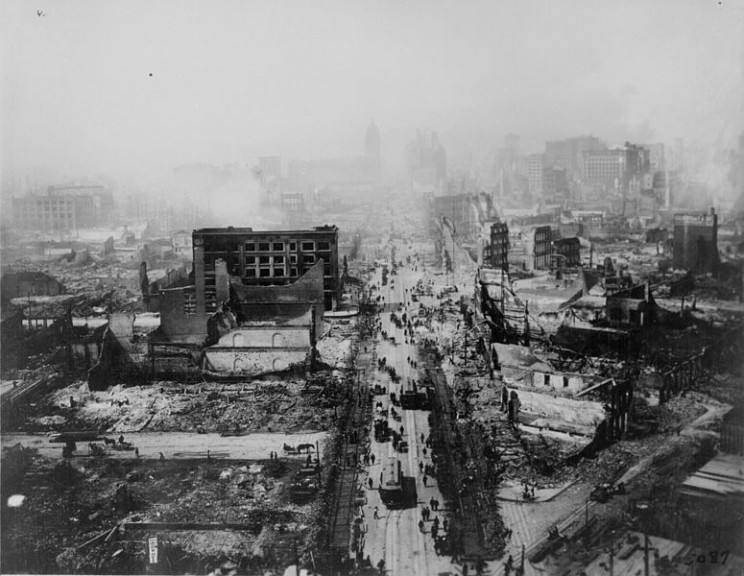
The bottom line is that while the human race may find itself, at some point in the future, in dire straits as a consequence of its own arrogance, aggression, or plain stupidity, this is by no means guaranteed. On the contrary, we can be 100 percent certain that at some point we will need to face the awful consequences of an exploding super-volcano or a chunk of rock barreling into our world that our telescopes have missed. Just because such events are very rare does not mean that we should not start thinking now about how we might prepare and cope with the aftermath. It does seem, however, that while it is OK to speculate at length upon the theoretical threat presented by robots and artificial intelligence, the global economic impact of the imminent quake beneath Tokyo, to cite one example of forthcoming catastrophe, is regarded as small beer.
Our apparent obsession with technological threats is also doing no favours in relation to how we view the coming climate cataclysm. While underpinned by humankind’s polluting activities, nature’s disruptive and detrimental response is driven largely by the atmosphere and the oceans, through increasingly wild weather, remorselessly-rising temperatures and climbing sea levels. With no sign of greenhouse gas emissions reducing and concentrations of carbon dioxide in the atmosphere crossing the emblematic 400 parts per million mark in 2013, there seems little chance now of avoiding a 2°C global average temperature rise that will bring dangerous, all-pervasive climate change to us all.

The hope is that we come to our collective senses and stop things getting much worse. But what if we don’t? A paper published last year in the Royal Society’s Philosophical Transactions, and written by lauded NASA climate scientist, James Hansen and colleagues, provides a terrifying picture of what out world will be be like if we burn all available fossil fuels. The global average temperature, which is currently a little under 15°C will more than double to around 30°C, transforming most of our planet into a wasteland too hot for humans to inhabit. If not an extinction level event as such, there would likely be few of us left to scrabble some sort of existence in this hothouse hell.
So, by all means carry on worrying about what happens if terrorists get hold of ‘the bomb’ or if robots turn on their masters, but always be aware that the only future global threats we can be certain of are those in nature’s armoury. Most of all, consider the fact that in relation to climate change, the greatest danger our world has ever faced, it is not terrorists or robots – or even experimental physicists – that are to blame, but ultimately, every one of us.
The post The biggest threat to the world is still ourselves appeared first on OUPblog.
Blog: the dust of everyday life (Login to Add to MyJacketFlap)
JacketFlap tags: volcano, DINOSAUR, alien, asteroid, Peggy Collins, Add a tag
"Mommy, where did all the dinosaurs go?"
"Well, some say it was a giant asteroid crashing into earth, others think it was a giant volcano...etc.. then.."
Quiet for a minute...
"Mommy,"
"Yes?"
"I think it was aliens. They landed in the ocean and caused these volcanoes. Then the dinosaurs went away. I think they went to the beach though, or maybe the forest."
The next day, at dinner, she insists she cannot sit still, because SHE is an asteroid.
Did you know that asteroids do not eat asparagus?
(And of course, I am now creating something out of this!)
Blog: Ellis Nadler's Sketchbook (Login to Add to MyJacketFlap)
JacketFlap tags: drawing, ink, volcano, pen, landscape, Nadler, wash, panels, sea, Add a tag
From an unrealized project, sketches for a further 54 views of Mt.Fuji. Previous efforts here and here.
Pen and wash, each page 19cm x 12cm. Click to enlarge.
Blog: Kid Lit Reviews (Login to Add to MyJacketFlap)
JacketFlap tags: pirates, Children's Books, Interviews, picture book, princess, pizza, animals, ocean, volcano, baby, surfing, cousins, pineapples, ships, flying, rockets, spies, Digital Book, islands, sword fighting, queens, 4stars, Library Donated Books, Chase Olivera, Adam Goodman, Ali Bali, Cahse Danger Super Spy, giant sharks, hang gliders, Jack Tracksler, Lisa Olivera, Magic Fire Music Book, newborns, pineapple pizza, Add a tag
4 Stars Chase Danger, Super Spy: Pirates of Pineapple Island Chase & Lisa Olivera Adam Goodman 32 Pages: Ages: 4 to 7 ................... From Website: 7-year-old super-spies Chase Danger and Princess Ali Bali must think fast when they discover pirates have stolen Zalezgon’s magical pineapples. But that’s not all! Ali’s little brother Aiden has been [...]![]()
Blog: Ellis Nadler's Sketchbook (Login to Add to MyJacketFlap)
JacketFlap tags: man, tree, cartoon, watercolour, ink, volcano, words, pen, landscape, Nadler, hat, architecture, moon, sea, transport, brush, bridge, gouache, biro, children, Add a tag
I partook of The Enchanted Kettle and before I knew it I had delivered a fresh Moon to the Hawaiians. Unfortunately the islands were abandoned: the inhabitants had been severely traumatised by reading Tales Told to Polish Children. Several queer and lowly creatures carried my brushes away.
Watercolour, gouache and biro. A4 size. Click to enlarge.
Blog: OUPblog (Login to Add to MyJacketFlap)
JacketFlap tags: global warming, Video, volcano, climate, giant, climate change, mcguire, earthquakes, Ice Age, tsunamis, volcanoes, waking, *Featured, Environmental & Life Sciences, Science & Medicine, Bill McGuire, Waking the Giant, geophysical, Add a tag
Could we be leaving our children not only a far hotter world, but a more geologically unstable one too?
In Waking the Giant, Bill McGuire argues that now that human activities are driving climate change as rapidly as anything seen in post-glacial times, the sleeping giant beneath our feet is stirring once again. The close of the last Ice Age saw not only a huge temperature hike but also the Earth’s crust bouncing and bending in response to the melting of the great ice sheets and the filling of the ocean basins — dramatic geophysical events that triggered earthquakes, spawned tsunamis, and provoked a series of eruptions from the world’s volcanoes.
Click here to view the embedded video.
Bill McGuire is Professor of Geophysical and Climate Hazards at University College London. His books include Waking the Giant: How a changing climate triggers earthquakes, tsunamis, and volcanoes, Surviving Armageddon: Solutions for a Threatened Planet, and Seven Years to Save the Planet.
Subscribe to the OUPblog via email or RSS.
Subscribe to only environmental and life sciences articles on the OUPblog via email or RSS.
View more about this book on the ![]()
![]()
Blog: Ellis Nadler's Sketchbook (Login to Add to MyJacketFlap)
JacketFlap tags: people, volcano, words, Nadler, sculpture, architecture, print, hole, chimney, fire, woodcut, Add a tag

Card No. 16 in the ongoing series of woodcuts.
Woodcut 30cm x 20cm. Click to enlarge.
Blog: OUPblog (Login to Add to MyJacketFlap)
JacketFlap tags: volcano, Indonesia, place of the year, Jan Zalasiewicz, The Earth After Us, merapi, planet in a pebble, magma, engines, Geography, Featured, eruption, iceland, air travel, eyjafjallajokull, flight cancellations, Add a tag
By Jan Zalasiewicz
Volcanoes can take one by surprise. That was the case with Mount St. Helens, that famously erupted sideways rather than upwards, and it was certainly so, two millennia back, when sleeping Vesuvius awoke to bury Pompeii and many of its citizens. Eyjafjallajokull may not have been quite so dramatic, but its effects, in tearing a large hole in our complex and delicate network of global airline communication, certainly rippled around the world.
To a geologist, the presence of a volcano on Iceland isn’t at all surprising. After all, Iceland is literally, and continuously, splitting apart, as this island sits exactly on the Mid-Atlantic Ridge. That mighty planet-sized fracture is continuously oozing magma, as the Americas pull ever farther apart – by a couple of centimeters a year, maintained for over a hundred million years – from Africa and Europe.
What raised a few eyebrows, though (mine, for sure) was the sheer filthiness of the eruption, and the amount of ash that it hurled high into the atmosphere, to the alarm of airline companies just about everywhere. For volcanoes that sit astride mid-ocean ridges are by nature generally placid by nature. For sure, they produce what seem like spectacular firework displays for the TV cameras, and flowing lava can, here and there, play merry hell with real estate values.
This is nothing, though, compared to the paroxysmal eruptions – Krakatoa, Pinatubo and the like – that occur in those parts of the world where tectonic plates are colliding. The violence of such cataclysms can destroy a whole country (and even Krakatoa was small compared to the great eruptions of the deep geological past). So why was Eyjafjallajokull trying to behave like one of the bad boys?
One answer is ice. Lying far north, Iceland is a land not just of volcanoes but of glaciers too – one of which lies on top of Eyjafjallajokull. As the uprushing magma came into contact with this, the ice flashed into steam, the expansion of which added quite a bit of oomph to the eruption. The lava, in turn, rapidly chilled by the ice, solidified quickly as it emerged, the thermal stresses shattering it into countless tiny fragments. This produced lots of ash, to be carried high into the atmosphere in the steam-driven (turbo-charged, if you like) eruption plume. It’s a bit (only a bit, mind) like putting a lot of wet wood and leaves on to a bonfire. This was one smoky volcano, and it seriously annoyed the neighbours.
Volcanic ash, of course, is feared by airline pilots, and justifiably so. One of the scariest experiences in all of flight history took place in 1982 when a British Airways Boeing 747, carrying 263 people, flew into an ash cloud from an erupting Indonesian volcano, Mount Galunggung. Ash particles entered the jet engines, melted against the hot metal, and, in effect, clogged them with reconstituted magma. All four engines failed, and the airplane, now completely without power, began to plunge towards the Indian Ocean.
The pilots kept their nerve, and prepared to ditch into the sea, while at the same time trying to restart the engines. The attempts failed until, when just a few thousand meters above the sea, the engines – amazingly – coughed back into life. They were able to fly to Jakarta, and landed safely (though not without difficulty, as the windscreen was almost opaque through being sandblasted by the sharp ash particles).
They had been saved by the same phenomenon that made Eyjafjallajokull such a disruptive volcano: thermal shock. As the stricken airplane descended, the cold air rushing through the lifeless engines chilled the molten ash, freezing it into solid volcanic glass. The chilling was fast enough for thermal stresses to shatter this glass, causing enough of it to break off to allow the engines to re-start. It was a lucky squeak.
That
Blog: Ellis Nadler's Sketchbook (Login to Add to MyJacketFlap)
JacketFlap tags: philosophy, volcano, words, Nadler, print, conceptual, woodcut, unconscious, Add a tag
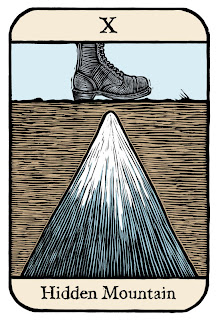 Card No.10 in the current series, hot off the press. The Hidden Mountain could be beneath your feet right now.
Card No.10 in the current series, hot off the press. The Hidden Mountain could be beneath your feet right now.
Woodcut 30cm x 20cm. Click to enlarge.
Blog: OUPblog (Login to Add to MyJacketFlap)
JacketFlap tags: podcast, volcano, A-Featured, Lexicography, Dictionaries, dictionary, Podictionary, Charles Hodgson, word origin, etna, eyjafjallajökull, volcanoes, mount, spewed, “furnace, Add a tag
iTunes users can subscribe to this podcast ![]()
 The volcano that spewed ash into the Icelandic skies and disrupted world air travel has a name that’s pretty difficult to pronounce and pretty difficult to spell; it’s Eyjafjallajökull. This evidently means “island mountain glacier.” Nothing about volcanoes, fire or ash in that word.
The volcano that spewed ash into the Icelandic skies and disrupted world air travel has a name that’s pretty difficult to pronounce and pretty difficult to spell; it’s Eyjafjallajökull. This evidently means “island mountain glacier.” Nothing about volcanoes, fire or ash in that word.
The volcano that was first called a volcano, however, does have a name relating to its fiery fame. Mount Etna is on the island of Sicily which is the island that the boot of Italy is kicking. The name Etna is thought—according to Adrian Room’s book Placenames of the World—to have originated from a Phoenician word attuna meaning “furnace.” He dismisses the theory that Etna is from a Greek source meaning “I burn.”
Mount Etna holds a place in Roman mythology as the furnace of the god of fire and blacksmithing. That god’s name was Vulcan hence the word volcano which appeared as an English word in 1613 in the travel writings of Samuel Purchas. So from that day to this travel and volcanoes seem to be strangely linked.
Five days a week Charles Hodgson produces Podictionary – the podcast for word lovers, Thursday episodes here at OUPblog. He’s also the author of several books including his latest History of Wine Words – An Intoxicating Dictionary of Etymology from the Vineyard, Glass, and Bottle.
Blog: Ellis Nadler's Sketchbook (Login to Add to MyJacketFlap)
JacketFlap tags: car, watercolour, ink, volcano, pen, landscape, machine, Nadler, sculpture, Add a tag
 a) I was inspired to do some landscape painting up in Berwickshire this week past.
a) I was inspired to do some landscape painting up in Berwickshire this week past.
b) Found a thin powdering of volcanic ash on the motor when I came down this morning.
c) Statements a and b above are not necessarily connected.
Pen and ink with watercolour. A5 size. Click to enlarge.
Blog: Peggy Collins Illustration (Login to Add to MyJacketFlap)
JacketFlap tags: volcano, dinosaur, cockroach, Add a tag




With all of the focus shifting to graphic novels (this is a graphic picture book I guess), I thought I would post one of my most fun books - written by Susan Hughes and published by Scholastic, here are some images from The End of the Dinosaurs - a comic strip. Narrated by a cockroach. I never realize how much character a cockroach could have, till I had to feature them in not one, but two books.
Blog: Ellis Nadler's Sketchbook (Login to Add to MyJacketFlap)
JacketFlap tags: food, animals, mythology, ink, volcano, cloud, bird, pen, mouth, Nadler, panels, castle, clay, Add a tag
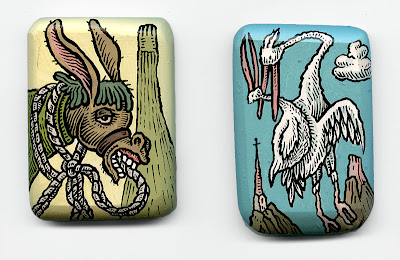 Two more clay tablets.
Two more clay tablets.
Polymer clay,acrylic paint and ink. Approx. 35mm x 50mm each.
Blog: OUPblog (Login to Add to MyJacketFlap)
JacketFlap tags: global warming, volcano, tsunami, disasters, climate, mcguire, catastrophes, volcanic, earthquakes, eruption, Add a tag

No one can escape the hundreds of articles and reports into global climate change: it is one of the most important issues on the political landscape in countries across the world. For this month’s Very Short Introduction column, I put a few questions to Bill McGuire, author of Global Catastrophe: A Very Short Introduction. McGuire is Director of the Benfield UCL Hazard Research Centre and has authored or edited over 400 books, papers and articles focusing on volcano instability and monitoring, volcanic hazards, natural hazards and environmental change, climate change and global geophysical events. He has worked on or visited volcanoes all over the world, including Mount Etna, Pinatubo and Ta’al in the Philippines, and Soufriere Hills in Montserrat.
OUP: Over the last few years we have seen an alarming increase in natural disasters, such as the Asian tsunami and subsequent earthquakes in the region. Can this rise be put down simply to climate change, or are there other possible explanations?
BILL McGUIRE: We have indeed been seeing a rise in the numbers of natural disasters, especially since 1990. This does not necessarily mean, however, that there have been more natural hazards. Climate change is already driving up the numbers of extreme weather events, such as storms and floods, and this is clearly having an impact. So far, however, we are not seeing any increase in the number and scale of geological hazards such as earthquakes, tsunamis and volcanic eruptions. The main reason for more natural disasters in recent years is that there are ever more people living in vulnerable regions, particularly in the coastal zone.
 OUP: At the same time as being faced with more and more reports about global warming, and the melting polar ice caps, we also hear about a possible new ice age. How can we have an ice age when the earth is getting warmer?
OUP: At the same time as being faced with more and more reports about global warming, and the melting polar ice caps, we also hear about a possible new ice age. How can we have an ice age when the earth is getting warmer?
McGUIRE: Current global warming is happening and is unequivocally due to human activities. There is no new ice age on the horizon, and in fact the next one - which would normally be expected within 10,000 years or so - may be postponed by our warming activities for up to half a million years.
If the gulf stream and associated Atlantic currents shut down in the next few decades, we could see a temporary cooling of the UK, Europe and the eastern US, but this would be far from an ice age, and warming would soon take over once more.
OUP: You say in your book that the human race “came within a hair’s breath of extinction” after a massive volcanic eruption 74,000 years ago. How do we know this, and what saved us then? Could the same thing happen now?
McGUIRE: Studies of mitochondrial DNA reveal evidence of a human population crash around about the time of the Toba super-eruption. This is known because we are so genetically similar that everyone alive today must be descended from a limited gene pool at about this time. It may be that just a few thousand humans survived the effects of the blast on the climate, possibly in tropical regions where the succeeding volcanic winter may have been less intense. This remains, however, highly speculative.
OUP: You suggest that the human race can try to preserve itself by moving into space, therefore potentially outliving Earth. Is the move into space really a realistic proposition?
McGUIRE: The only things hindering the colonisation of space are political will and money. Given time, I expect both obstacles to be overcome, leading to our race eventually reaching the stars. The big question is whether this would be good thing - bearing in mind how we have treated our own planet and those species we share it with? It may also be that the economic and social collapse that dangerous climate change looks increasingly likely to bring will set us back for generations.
OUP: Once people have read Global Catastrophes: A Very Short Introduction, which five books would you point them to next?
McGUIRE: Surviving Armageddon: Solutions for a Threatened Planet (also by me) suggests possible solutions to some of the potential catastrophes addressed in ‘global catastrophes’.
To find out how close we are to the oil running out, with consequent economic mayhem, I recommend The Last Oil Shock: A Survival Guide to the Imminent Extinction of Petroleum Man by David Strahan
The greatest threat to our race and our planet currently lies in contemporary climate change, so I would direct the reader to: Six Degrees by Mark Lynas and The Rough Guide to Climate Change.
Finally, I would (naturally) recommend my new climate change book Seven Years to Save the Planet due to be published in July (in the UK) by Weidenfeld & Nicholson.
Blog: Ellis Nadler's Sketchbook (Login to Add to MyJacketFlap)
JacketFlap tags: machine, mouth, eye, Nadler, coat, hat, psychology, sculpture, hole, nose, heraldry, bridge, chimney, sword, travel, tree, people, ink, volcano, pen, machine, psychology, sculpture, hat, sword, mouth, Nadler, eye, nose, heraldry, chimney, bridge, hole, coat, Add a tag
 Card no.7 in a series of 78.
Card no.7 in a series of 78.
Copic markers and Staedtler pens. 12cm x 8cm. Click to enlarge.
Blog: Ellis Nadler's Sketchbook (Login to Add to MyJacketFlap)
JacketFlap tags: books, tree, religion, animals, people, watercolour, volcano, machine, boat, hat, Nadler, glasses, wheels, chimney, Add a tag
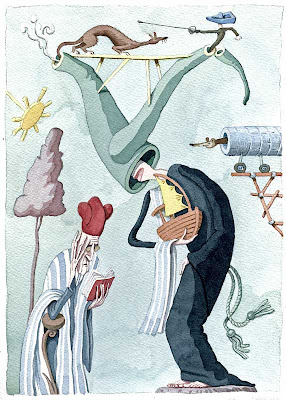 Watercolour 25cm x 18cm. Click to enlarge.
Watercolour 25cm x 18cm. Click to enlarge.
Blog: Ellis Nadler's Sketchbook (Login to Add to MyJacketFlap)
JacketFlap tags: travel, people, cartoon, watercolour, ink, paint, volcano, pen, hat, Nadler, eye, glasses, Add a tag
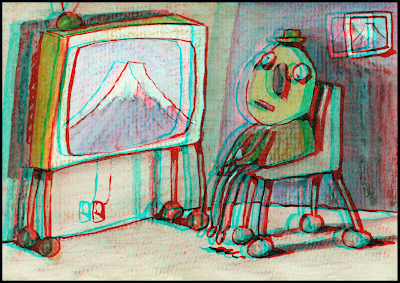 You need those 3D specs to view this anaglyph conversion courtesy of The Wagman.
You need those 3D specs to view this anaglyph conversion courtesy of The Wagman.
Original image Pentel brushpen with water-soluble crayon. Postcard size. Click to enlarge.
Blog: Books4Ever (Login to Add to MyJacketFlap)
JacketFlap tags: children's, fantasy, children's book, audiobook, magic, volcano, island, stone mage, Add a tag
 In the sequelish to Street Magic, Evvy goes with Rosethorn to a small island to find out what is killing all the plants and animals. It turns out that it is a volcano and it is up to Evvy to try and save the island. That is the basic plot of the story, but it is really more about Evvy learn to love humans. She loves rocks, but doesn’t really care if people live or die and it is in this book that she must learn to do so. Pierce released this book first as an audio. It won’t release as a book until 2008. Bruce Coville’s Full Cast Audio did the book. It is the first book (supposedly) to be released as an audio first. I don’t know how I feel about the full cast audio. On one hand, I found Evvy’s voice a bit annoying, but then because there were other voices, I did not have to listen to only that voice. I think I will try another and see if I like it. I think it is admirable that they are trying to make audiobooks important, but I don’t know if it will work. Although I have to note that I wanted to read it and so instead of waiting a year I did pick up the audio so maybe it did work.
In the sequelish to Street Magic, Evvy goes with Rosethorn to a small island to find out what is killing all the plants and animals. It turns out that it is a volcano and it is up to Evvy to try and save the island. That is the basic plot of the story, but it is really more about Evvy learn to love humans. She loves rocks, but doesn’t really care if people live or die and it is in this book that she must learn to do so. Pierce released this book first as an audio. It won’t release as a book until 2008. Bruce Coville’s Full Cast Audio did the book. It is the first book (supposedly) to be released as an audio first. I don’t know how I feel about the full cast audio. On one hand, I found Evvy’s voice a bit annoying, but then because there were other voices, I did not have to listen to only that voice. I think I will try another and see if I like it. I think it is admirable that they are trying to make audiobooks important, but I don’t know if it will work. Although I have to note that I wanted to read it and so instead of waiting a year I did pick up the audio so maybe it did work.

Blog: Ellis Nadler's Sketchbook (Login to Add to MyJacketFlap)
JacketFlap tags: travel, people, ink, volcano, landscape, panels, engraving, chimney, hat, Nadler, scraperboard, Add a tag
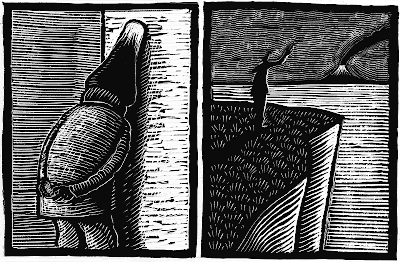 Two more views of Mt.Fuji. A continuing series.
Two more views of Mt.Fuji. A continuing series.
Scraperboard 8cm x 5cm. Click to enlarge.
Blog: Ellis Nadler's Sketchbook (Login to Add to MyJacketFlap)
JacketFlap tags: chimney, travel, dog, animals, ink, volcano, panels, Nadler, engraving, scraperboard, Add a tag
 Continuing my series "One Hundred Views of Mt.Fuji".
Continuing my series "One Hundred Views of Mt.Fuji".
Scraperboard 11cm x 5cm. Click to enlarge.
Blog: Ellis Nadler's Sketchbook (Login to Add to MyJacketFlap)
JacketFlap tags: scraperboard, volcano, death, landscape, machine, sculpture, plane, panels, Nadler, wheels, transport, Add a tag
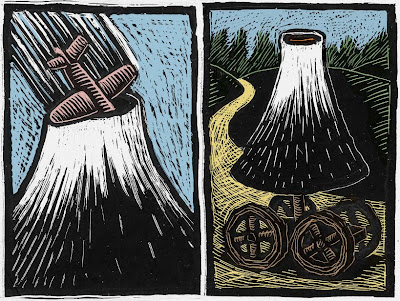 Two views of Mt.Fuji, part of a series.
Two views of Mt.Fuji, part of a series.
Scraperboard 7cm x 5cm. Click to enlarge.
Blog: Big and Little Art (Login to Add to MyJacketFlap)
JacketFlap tags: collage, volcano, Laura Zarrin, Add a tag

I've been wanting to try collage knowing the kids would enjoy it. I had thought to just paint a plain, textured background and then create a collage on top. The kids, of course, had other ideas. They're boys, so volcano's, destruction, and mayhem are key. Here's the result. I gave them some color mixing advice, they did the rest. Josh's is on the left, Kiyon's on the right.
By: Laura Zarrin, Kiyon age 9, Josh age 6
Creative Whimsies
Blog: Saipan Writer (Login to Add to MyJacketFlap)
JacketFlap tags: Saipan, pollution, kvetch, volcano, Add a tag
The haze from the eruption at Anatahan lingers over Saipan today (Monday). Yesterday, when I didn't yet know about the air quality problem, I thought I was getting the flu. Today, I just keep coughing, can't breathe, have a headache. There's an advisory for people with "respiratory illnesses" to stay indoors, and I thought it didn't apply to me. But either I have such an illness or the warning is too limited in scope.
It doesn't help to drive around because the emissions from jalopies and tour buses and trucks go unchecked. Today, it seems that every other vehicle is spewing smoke and oil. This unregulated pollution isn't good for our environment. It isn't good for our "tourist industry." And it certainly isn't good for my health.
So it's not a good day in paradise, and I'm finished kvetching for now.




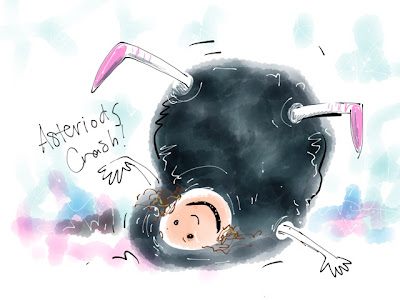



All too reminiscent of volcanoes and earthquakes for us.
There is also hidden earth.
Hidden meaning?